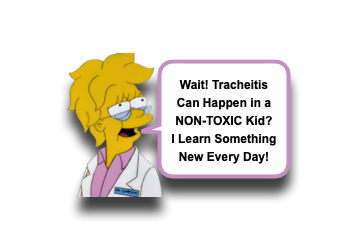Tracheitis in Children: a 2018 Update
- Mar 19th, 2021
- Sean M. Fox
- categories:
Originally published at Pediatric EM Morsels on November 30, 2018. Reposted with permission.
Follow Dr. Sean M. Fox on twitter @PedEMMorsels
Oh, the cacophony of coughing: it is like the theme music to the Pediatric ED during the winter months. While often benign, we do need to consider many conditions that may be the cause (ex, Pneumonia, Bronchiolitis, Asthma, Heart Failure). There is also a particularly characteristic cough that often leads to the triage team giving you the “diagnosis” of Croup. Croup can be “fun” to manage – it is a clinical diagnosis that you can treat and you can make the kid feel better – but, what do you do when the “croup” doesn’t respond like you’d expect? Recurrent Croup and “Croup” that fails therapy desires specific attention. You may be dealing with Tracheitis! Let us take a moment to update ourselves on Tracheitis in children!
Tracheitis in Children: Basics
- Tracheitis is an inflammatory process of the trachea!
- That inflammation can be due to:
- It is Dangerous!
- It can be a true medical emergency.
- While rare, it has emerged as the most common potentially life-threatening upper airway infections in children. [Hopkins, 2006]
- Traditionally, described as leading to critically ill and toxic appearing patients.
- Thick exudative plaques can obstruct the airway!
- Epidemiology has been shown to be changing, though, and can present with less severe disease. [Casazza, 2018]
- It’s All Connected!
- Ok, this is obvious, but we often think of conditions as being isolated… pneumonia is in the lungs, croup is the trachea, pharyngitis is in the pharynx…
- But, those processes can overlap adjacent regions.
- Isolated Tracheitis is rare. [Blot, 2017]
- Inflammation usually affects continuous structures also.
- Larngotracheitis, tracheobronchitis, laryngotracheobronchitis (which also refers to croup)
- Pediatric Bacterial Tracheitis:
- Should be considered when there is a toxic appearance or poor/no response to therapies (ex, steroids, racemic epi). [Blot, 2017]
- Now most likely due to S. Aureus, often MSSA. [Casazza, 2018; Tebruegge, 2009; Hopkins, 2006]
- H. influenzae was once most common, but now reduced frequency due to HiB vaccine (although still ~16% of cases).
- Viral Coinfection can be seen in ~30% of cases. [Casazza, 2018; Blot, 2017; Tebruegge, 2009]
- Typically will have had a “viral prodrome.”
- May have even begun as viral Croup or “the Flu.”
Tracheitis in Children: Presentation
- It’s Challenging to Diagnosis!
- With the overlapping conditions and the more common entities presenting similarly, it can be difficult to pick up on.
- Standard imaging does not reliably diagnosis it.
- It can present dramatically or subtly.
- Requires high index of suspicion for subtle cases.
- Presentation:
- May look similar to: [Blot, 2017]
- Epiglottitis
- Tracheal Foreign Body
- Retropharyngeal Abscess
- Tracheal Edema (ex, anaphylaxis)
- Diphtheria
- Symptoms similar to other causes of airway obstruction. [Blot, 2017]
- Tachypnea
- Stridor
- Hoarse voice
- Cough (may be productive or may have coughing fits — hmmm, like pertussis)
- Dyspnea and agitation
- Fever
- Fever is not always seen with viral croup…
- More frequently seen with bacterial tracheitis, although not necessary.
- Nosocomial / healthcare associated tracheitis presents differently. [Blot, 2017]
- Patients with tracheostomy may have bacterial colonization of their stoma that then infects their adjacent trachea.
- Patients with endotracheal tubes can develop ventilator-associated bacterial infection.
- May present with fever, increased secretions, change in secretions, or increased oxygen requirement.
- May look similar to: [Blot, 2017]
- Community Acquired Bacterial Tracheitis – It’s a Spectrum
- May present with Toxic Appearance.
- Once taught to be the primary form.
- Recent study had only 17% presenting with Toxic Appearance. [Casazza, 2018]
- May actually be a continuum.
- Mild Upper Respiratory Infection -> Severe Bacterial Tracheitis
- “Exudative Tracheitis” is used to describe cases with exudate, but without systemic toxicity. [Casazza, 2018]
- May present with Toxic Appearance.
Tracheitis in Children: Management
- Toxic appearing?
- Treat similarly to what you would with Epiglottitis.
- Keep patient calm.
- Have patient taken to the OR for rigid bronchoscopy and, likely, intubation.
- Not exactly Toxic appearing, but not quite right?
- Have High Index of Suspicion!
- Patients with atypical course or who don’t respond to therapies are waving the red flag at you!
- Just diagnosed last week with Croup and now with recurrent stridor?
- Seemed like croup, but Racemic Epinephrine and Dexamethasone has made no difference?
- Bacterial Tracheitis should be considered with:
- Worsening stridor
- Respiratory distress
- High fever
- Orthopnea
- Dysphagia
- Patients with atypical course or who don’t respond to therapies are waving the red flag at you!
- Plain Films may help.
- PA and Lateral neck films and Chest Xray are often discussed. [Blot, 2017]
- CXR can show concomitant pneumonia (which would support bacterial tracheitis)
- PA/Lat neck films may show Steeple sign and an uneven/ragged tracheal wall concerning for intraluminal tracheal membranes.
- Flexible endoscopes can help! [Blot, 2017; Shargorodsky, 2010]
- Calling your ENT consultants early.
- Bedside scope or scope in the OR to evaluate the supraglottic structures is helpful:
- May show mucosal edema, pseudomembranes, ulcerations, microabscesses, and purulent secretions that don’t clear.
- Can rule-out epiglottis.
- If scope is abnormal, then would need full bronchoscopy.
- Have High Index of Suspicion!
- Treat the Patient!
- Look for signs of SHOCK and treat with Fluids and Pressors as needed.
- Ampicillin-clavulanic acid and a 3rd generation cephalosporin are typically selected to treat bacterial tracheitis. [Blot, 2017; Tebruegge, 2009]
Moral of the Morsel
- Be careful of “Recurrent Croup.” It may be bacterial tracheitis.
- Needing multiple doses of Racemic Epinephrine? Rethink that croup diagnosis.
- Don’t overlook Bacterial Tracheitis just because the patient is not toxic appearing.

